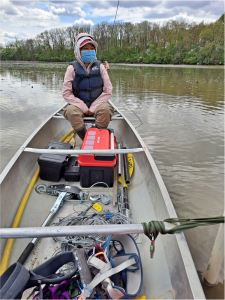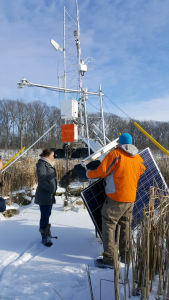From an operational comfort perspective (science be damned), ideally located flux sites should be placed somewhere easily accessible, near power connection and wireless data coverage, and, preferably, on solid ground. Old Woman Creek has none of the above. Located at the center of a Lake Erie coastal wetland, US-OWC hits all the high notes of an ideal scientific location – highest methane flux in the world, far from edges and disturbances, and with full wetland footprint at all wind directions. But the tradeoff for that is an operationally challenging location. It takes a 20-minute canoe ride (or longer if the lake-effect wind kicks up) to reach the tower. There is no dry ground anywhere around the tower, with water levels fluctuating between 30 and 100 cm above the soft mud.
We tie the canoe directly to the tower, wear our safety gear (not easy in a canoe, fine balance required) and climb without ever stepping on the ground. In the regrettable events that require getting into the water, the underlying mud sucks you up to about knee deep, while releasing intoxicating aromas of decomposing vegetation with notes of H2S, methane and bird manure.

Figure 2. Justine going to clean the IRGA. On the right, below the battery boxes, you can see the corner of the base of the collapsed solar-panel tower
The flux tower is powered solely by solar power (100% green and renewable flux tower) and has only the faintest hints of cellular wifi (Verizon, I hope you can hear me now…). All that is the regular operations. But around November, the wetland freezes. The ice is too thin to safely walk to the tower. We did that once, after the polar vortex of 2018 to reattach the solar panel that blew away in a wind event but that was scary, even for me. And so, the thin ice keeps us away from the tower during the winter. A set of 4 giant lithium-Ion batteries and 3 large solar panels can keep the tower running till about February. Then we lose contact. Like new parents that left their toddler for a full day in daycare for the first time, we eagerly wait for the ice to thaw and the spring to come so that we can finally check on our tower after the long winter.

Figure 3. Yang letting her finger thaw after serious work with the come along. Newly tightened guy wire visible behind her.
Driving toward the visitor center in March 2021, the bridge over Old Woman Creek offered a first glimpse of the tower. It did not look good. The optimistic side of my brain responded with “this is fine, it just looks bent because of the viewing angle and perspective”. But as we paddled our canoes closer and closer, we could not escape the reality that “this is bad”. The small tower that carried the solar panels was gone. We found it collapsed, under the water. No wonder the tower did not power up even after a whole sunny March week. The main tower was making its best to look like the leaning tower of Pisa. One snapped guy wire and one loose anchor let the tower lean by about 30 degrees. I ignored panicked visions of all the sensors falling into the water by thinking of how much this off-zenith angle would mess up the radiation measurements. We jumped into the water.
Breezy water temperature of 3 degrees C was accompanied by borderline comfortable 10 degrees air temperature (and windy). The mud, as always, bubbled with joy for our presence. We placed new anchors and pulled the towers up with a come-along winch. 4 hours later, and near hypothermia, we secured 2 new anchors and guy wires, tightened the existing wires, and reconnected the solar panels, which shockingly still worked. The tower came to life, and we could paddle back to shore to shiver with chill and satisfaction. Another winter had passed with no major incidents. Hopefully, next spring will be easier, but usually they are not.



What a fun read. Glad to hear OWC is still alive and producing data despite the challenges!